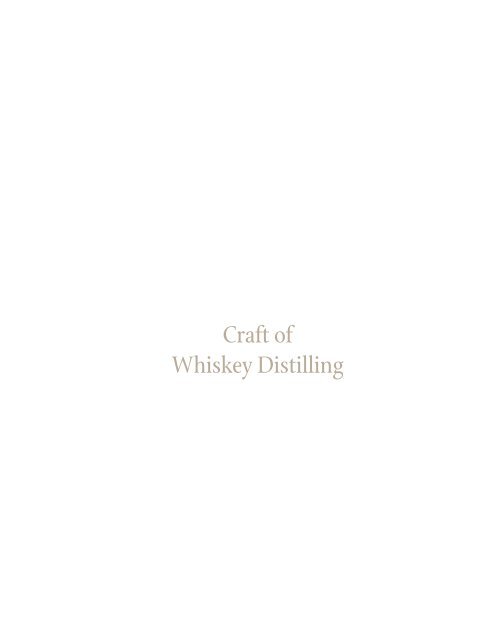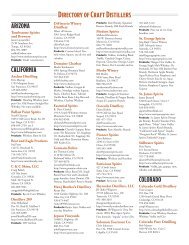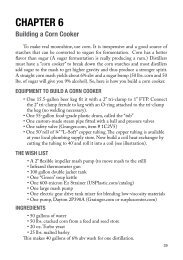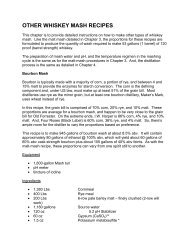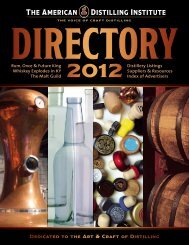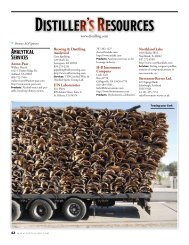Craft of Whiskey Distilling - The American Distilling Institute
Craft of Whiskey Distilling - The American Distilling Institute
Craft of Whiskey Distilling - The American Distilling Institute
You also want an ePaper? Increase the reach of your titles
YUMPU automatically turns print PDFs into web optimized ePapers that Google loves.
<strong>Craft</strong> <strong>of</strong><br />
<strong>Whiskey</strong> <strong>Distilling</strong>
<strong>Craft</strong> <strong>of</strong><br />
<strong>Whiskey</strong> <strong>Distilling</strong><br />
Published by<br />
<strong>The</strong> <strong>American</strong> <strong>Distilling</strong> <strong>Institute</strong> (ADI)<br />
<strong>The</strong> <strong>American</strong> <strong>Distilling</strong> <strong>Institute</strong> is the collective voice <strong>of</strong> a new generation <strong>of</strong> artisan distillers.<br />
We are dedicated to disseminating essential information regarding the art and science <strong>of</strong> distilling.
© Bill Owens<br />
All rights reserved<br />
2009<br />
ISBN 978-0-9824055-1-2<br />
For permission to reproduce any part <strong>of</strong> this book<br />
please correspond directly with<br />
White Mule Press<br />
Box 577<br />
Hayward, CA 94543<br />
Visit the <strong>American</strong> <strong>Distilling</strong> <strong>Institute</strong> website<br />
at www.distilling.com
AMERICAN DISTILLING INSTITUTE | VII
VIII | CRAFT OF WHISKEY DISTILLING
AMERICAN DISTILLING INSTITUTE | IX<br />
Preface<br />
<strong>The</strong> new generation <strong>of</strong> artisan whiskey distillers, whenever possible, use local ingredients<br />
to reflect the region <strong>of</strong> the country where they are located. <strong>The</strong>y also look to nearby<br />
microbrewers as a source <strong>of</strong> inspiration and sometimes wash. Brewing and distilling go<br />
hand in hand because the mash-tun can produce wort for brewing or wash for distilling.<br />
To distill whiskey you first have to make beer. Beer is a technical term for whiskey<br />
wash, regardless <strong>of</strong> the type <strong>of</strong> raw ingredients used. <strong>The</strong> microbrewer uses a mash-tun to<br />
produce a sweet barley water called wort. <strong>The</strong> same mash-tun can also be used to make<br />
wash for whiskey distillation. <strong>The</strong> difference is that distillers wash is un-hopped, contains<br />
no solids and most importantly, it will ferment in less then a week.<br />
<strong>The</strong> new generation <strong>of</strong> craft whiskey distillers, like Scottish distillers, will use a mashton<br />
to produce all malt whiskies. <strong>The</strong>y will use numerous beer recipes to produce a new<br />
generation <strong>of</strong> barley, rye and wheat whiskies. <strong>The</strong>se whiskies will have flavor and character<br />
not found in commercial corn whiskies. I also think that we’ll soon see a new generation <strong>of</strong><br />
whiskies infused with wood (apple, cedar, birch) and spices.<br />
<strong>Craft</strong> distillers don’t need a column still with two dozens <strong>of</strong> plates to make whiskey.<br />
Visit any small whiskey distillery and you will see that most have a still without column and<br />
plates. And, if they do have a column still, it will be used to make stripping runs with plates<br />
open. <strong>The</strong>n they make heads and tails cuts on the second spirits run using one plate. Every<br />
distillery works differently. <strong>The</strong> key is to make head tail cuts that save congeners (flavors)<br />
that define the style <strong>of</strong> whiskey you are distilling.<br />
Special thanks to Ian Smiley, who wrote the heart <strong>of</strong> the book, Distillation Principles.<br />
Also thanks to contributing writers Alan Dikty, George Ferris, Eric Watson, Zac Triement,<br />
Bill Smith, and Attorney Robin J. Bowen. Artwork is by Catherine Ryan and layout is by Uri<br />
Korn. To learn more about craft distilling, join the <strong>American</strong> <strong>Distilling</strong> <strong>Institute</strong> (ADI) at<br />
distilling.com. Member support helps educate the public about craft distilling.<br />
Bill Owens, President<br />
<strong>American</strong> <strong>Distilling</strong> <strong>Institute</strong>
X | CRAFT OF WHISKEY DISTILLING
AMERICAN DISTILLING INSTITUTE | XI<br />
<strong>The</strong> purpose <strong>of</strong> this manual—<br />
a barrel a week<br />
Introduction<br />
This manual is intended for the craft whiskey distiller who aims to make excellentquality<br />
malt whiskey through artisan distillation methods. This manual describes, at the<br />
craft level, the process <strong>of</strong> making whiskey. It gives detailed instructions on how to distill<br />
one barrel (53 gallons) <strong>of</strong> 120-pro<strong>of</strong> malt whiskey.<br />
<strong>The</strong> reader learns about the principles <strong>of</strong> distillation, types <strong>of</strong> stills, and the process <strong>of</strong><br />
distillation. <strong>The</strong> manual also goes into detail about how-to make head and tails cuts—the<br />
elusive operation that a distiller needs to learn in order to create a world class whiskey.<br />
Most important is the chapter on mashing and creating a barley wash for fermentation.<br />
<strong>The</strong> all-grain recipes in the manual are adapted from the mashing (brewing) process<br />
used by commercial malt whiskey distilleries. Finally, the wash will be distilled using the<br />
double-distillation method employed by most <strong>of</strong> the renowned malt-whiskey producers.<br />
<strong>The</strong> quantities in this manual are stated in Standard <strong>American</strong> Weights and Measures,<br />
and temperatures are in degrees Fahrenheit.<br />
DEFINITION OF “CRAFT”<br />
OR “ARTISAN” DISTILLER<br />
<strong>Craft</strong> distillers produce alcoholic beverage spi rits by distillation, or by infusion<br />
through distillation or re-distillation. Maximum production for a “craft” or “artisan”<br />
distiller should not exceed 250,000 pro<strong>of</strong> gallons per year. <strong>The</strong> “craft” or “artisan” distiller<br />
utilizes a pot still, with or without rectification columns, for distillation <strong>of</strong> beverage<br />
spirits. A distiller starting with neutral spirits produced by others, who redistills without<br />
substantially altering the neutral character <strong>of</strong> the spirit may not be said to be a “craft” or<br />
“artisan” distiller.
abv Alcohol by Volume.<br />
XII | CRAFT OF WHISKEY DISTILLING<br />
Aldehyde A volatile impurity found<br />
in heads; <strong>of</strong>ten redistilled separating<br />
it from alcohol.<br />
Barrel (Wooden) 53 U.S. gallons,<br />
44 Imperial gallons or 200.6 liters.<br />
Barrel (Beer) 31 gallons.<br />
Beer Stripping <strong>The</strong> process <strong>of</strong> running<br />
wash through a still (no head or<br />
tail cuts) to remove alcohol that will<br />
be re-distilled. A stripping run usually<br />
starts at 170 pro<strong>of</strong> and ends at<br />
70 pro<strong>of</strong> .<br />
Beer Stripper A large pot still, without<br />
plates, used to strip wash for a<br />
second distillation.<br />
Bubble Caps Caps sit on trays over<br />
vapor tubers in the column still<br />
(sprits still). Caps provide contact<br />
between the rising vapors and descending<br />
reflux crating a distillation<br />
cycle and enriching the alcohol.<br />
CFR Code Federal Regulations; U.S.<br />
Government regulations, “Type <strong>of</strong><br />
Definition” for example: rye whiskey<br />
must be fermented mash <strong>of</strong> not less<br />
that 51% rye and stored in a new oak<br />
container.<br />
Charge <strong>The</strong> volume <strong>of</strong> wash to be<br />
distilled.<br />
Condensor <strong>The</strong> apparatus, <strong>of</strong>ten a<br />
tube in shell, in which a vapor condenses<br />
to liquids.<br />
Congeners Impurities. This minor<br />
chemical gives liquor (spirits) a distinctive<br />
character and flavors. It’s<br />
found in both heads and tails,<br />
Glossary<br />
Dephlegmator A chilling apparatus<br />
(condenser) at the top <strong>of</strong> the reflux<br />
column. It is comprised <strong>of</strong> a bank<br />
<strong>of</strong> tubes with cold water running<br />
through them. This increases reflux,<br />
and the purity <strong>of</strong> the distillate.<br />
Dextrose Basic sugar know as corn<br />
sugar. A base for distilling whiskey<br />
(moonshine).<br />
DSP Distilled Spirits Plants; a federally<br />
licensed distillery.<br />
Double <strong>Distilling</strong> A process where<br />
the distillate is distilled twice. <strong>The</strong><br />
first time to remove alcohol and the<br />
second distillation is make cutting<br />
the head and tail cuts.<br />
Fractional Distillation Done in column<br />
still using plates and bubble<br />
caps. <strong>The</strong> process separates spirits<br />
into different volatility.<br />
Heads Is the first spirits <strong>of</strong>f the still,<br />
contain several undesirable chemical<br />
such as aldehydes. Heads are<br />
collected and then <strong>of</strong>ten re-distilled<br />
as distillers try remove the flavorful<br />
congeners.<br />
Mash Is produced by mixing hot water<br />
and grains.<br />
Mash-Lauder A process that mechanically<br />
mixes barley and water.<br />
Mash Tun A double jacketed tank<br />
in which hot water and grains are<br />
mixed. <strong>The</strong> tank (mash-tun) has a<br />
false bottom (a screen or slotted<br />
tubes) allowing the sweet barley<br />
water to drain. Distiller collects the<br />
barley water for fermentation. After<br />
fermentation it becomes wash that<br />
is then distilled
AMERICAN DISTILLING INSTITUTE | XIII<br />
Moors Cap A still with a flat top<br />
(hat) <strong>The</strong> cap catches reflux, sending<br />
it back to the kettle for re-distillation.<br />
NGS Neutral Grain Spirits. (190+<br />
Alcohol) In the USA it is produced<br />
from corn. NGS I used by distilleries<br />
around the world for blending, vodka,<br />
gin, whiskey etc. It is the workhorse<br />
<strong>of</strong> the distillation industry and<br />
used by all many distilleries producing<br />
100s or products.<br />
pH A measure <strong>of</strong> the acidity or alkalinity<br />
<strong>of</strong> a solution, equal to 7 for<br />
neutral solutions, increasing with<br />
increasing alkalinity and decreasing<br />
with increasing acidity. <strong>The</strong> pH scale<br />
used ranges from 0 to 14.<br />
Parrot A device that looks like a<br />
parrot, the bird, with a long beak.<br />
It holds the hydrometer— collects<br />
and cools alcohol running from the<br />
still. This allows the distiller to know<br />
the percent alcohol flowing from the<br />
still.<br />
Pro<strong>of</strong> An <strong>American</strong> term used to determine<br />
the strength <strong>of</strong> the alcohol.<br />
For example; 120 pro<strong>of</strong> is 60% alcohol<br />
or abv.<br />
Relfux When vapors in the still are<br />
cooled they fall back into the still as<br />
liquid. <strong>The</strong> amount <strong>of</strong> the reflux obtained<br />
depends on the shape <strong>of</strong> the<br />
still and the angle <strong>of</strong> the lyne arm.<br />
Reflux Column A column which<br />
cycles liquids through two or more<br />
distillations. Used to make NGS.<br />
Spirit Still A still designed to do the<br />
final distillation producing finished<br />
whiskey.<br />
Spirit Run <strong>The</strong> final distillation that<br />
produces the finished whiskey.<br />
TTB Tobacco Tax and Trade Bureau<br />
formerly BATF. It licenses and collects<br />
taxes from U.S.distilleries.<br />
Tails Alcoholic distillate containing<br />
a high percentage <strong>of</strong> fusel oil.<br />
Tote A large stainless steel tank for<br />
transporting and storage <strong>of</strong> spirits.<br />
Wash Fermented barley water.


